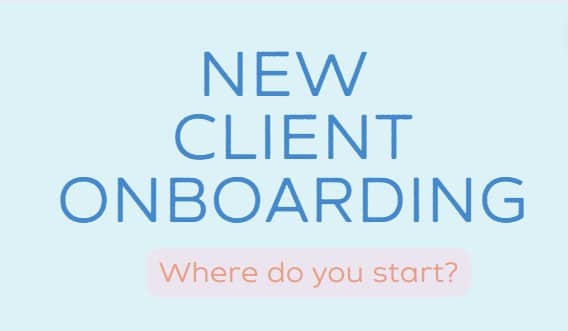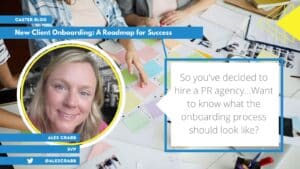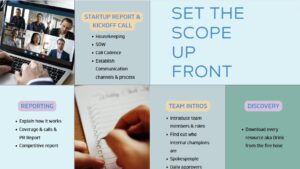
Onboarding with a PR Agency: 4 Step Process

So you’ve decided to hire a PR agency – what should the onboarding process look like?
In this blog, I’ll talk about what it’s like to start a PR engagement and the four key components of the onboarding process that set the foundation for success. PR is not a tap that can be turned on and provide instant coverage. Instead, there is startup time involved to create a strong foundation for the program and that startup time involves several steps.
Here’s what to expect:
The Foundation: People and Processes
At this step in the process, there are several housekeeping issues the new client and PR Agency should go through to understand roles, responsibilities, communication channels, and cadence. In this process, we’re ensuring we truly understand our client, their expectations, and their work style, and that they understand ours.
- Teams: We need to learn about each other. We should all understand who is part of this team – both from the agency side and the internal side. Caster always takes a team approach, so the first thing we do is establish who the agency team is, the role of each person on the team, and determine your central point of contact. But to be successful, we also need to know who our internal champions will be – who will be our guide – the person to connect us with everything we need from a client. We’ll also ask who the central point of contact is for feedback/approvals.
- Expectations: Hopefully, during the new business pitching phase, we’ve already established a shared sense of success and agreed upon metrics and evaluation. These key performance indicators (KPIs) are never the same for every client – they are tailored to the Scope of Work (SOW) defined during the proposal process. However, sometimes it is a mystery to new clients how we measure against those KPIs. During this point in the process, we explain how reporting works, so the client has a firm idea of what to expect. We talk through our PR report – an ongoing and real-time summary of all the actions, idea share, and work status at any given time. We share coverage and metrics reports with an executive summary at each month’s end. For those, we set up dashboards in our enterprise-level reporting tools – Muckrack, Meltwater, and SproutSocial – to monitor coverage and social listening. We also always review the Scope of Work to make sure all parties are on the same page for what we’ve agreed to work on together, and I like to get aligned on some quick-win priorities that our team can deliver while the more extensive campaigns are being developed – a key part of building trust with the client.
- Communication: We want to make sure it is very clear how we’re going to communicate. Not all clients have the same preference for communication methods – some prefer Slack and GoogleDocs while others prefer traditional email and Zoom calls. No matter how we share documents and communicate daily, we always arrange a cadence for an ongoing recurring Zoom or Teams call with everyone that needs to be involved from both sides so that we can share progress and get answers.
The Roadmap: Discovery
During the discovery phase, we conduct a deep dive into your business. This step is essential because it is where we learn about our clients’ business, understand the company roadmap, and flag any important milestones or issues we’ll need to leverage or watch out for. We want to download and absorb as much information as possible. This is usually done during initial intake meetings or SWOT (Strengths, Weaknesses, Opportunities, Threats) interviews with key stakeholders. We also go through all the resources that you can share with us.
I call this the Discovery Checklist:
- Messaging, personas, taglines
- Logos and brand guides
- Current marketing and PR efforts in play
- Bios, headshots, domains and media-readiness of key people empowered to speak on the client’s behalf
- Approved graphics/images/screenshots
- Presentation decks – Analyst, IR/Pitch, and Public
- Private FAQs
- Competitor analysis
 Checklist for onboarding
Checklist for onboarding
The PR Toolkit
While the foundational housekeeping and discovery are underway, the team at Caster also begins building out the PR Toolkit, in tandem. These are the tools necessary to do the work. This part can go a lot faster if you share with us your target markets, audiences, and even wish list for events and press, in addition to any outreach or activities you’ve done already or press or analysts that you’ve recently spoken to.
- Media Lists by target and vertical market
- Speaking opportunity calendar
- Analyst calendar
- Editorial calendar
- Awards calendar
- Social media calendar
We also use every opportunity to leverage any content you’ve already built up. This could be whitepapers, blogs, articles, speaking abstracts, or presentations. The more you have and share with us during the discovery phase, the better. We can work this into our content and editorial calendar. During this process, we also explore spokespeople and work with the client to make a matrix of spokespeople and topics.
Execution:
After completing the first three steps, we work with clients to develop a quarterly plan that aligns with priorities and other marketing activities. From there, we work to deliver the results outlined in that plan, and hopefully, we both have some fun along the way!
While not every client starts the same exact way, there is always a significant investment of time from both the client and the PR agency. However, the onboarding process is essential to a successful PR program. At Caster, our onboarding programs are extensive. I believe they are one of the reasons we have a solid success rate early on with clients and many long-term clients. This process allows the agency to become a member of the client’s marketing team, truly understanding the business and goals to ensure we capitalize on highly strategic opportunities.

